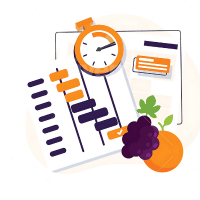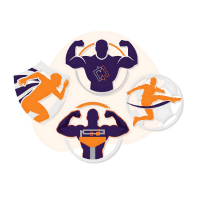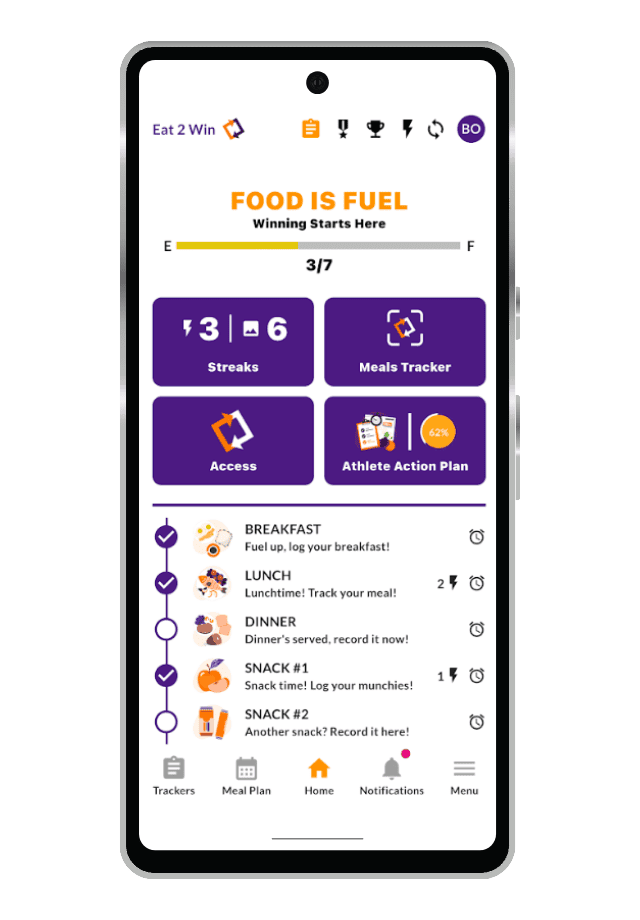Your athletes need to eat carbs every day because they fuel the brain and give muscles energy.1,2 In fact, athletes need one gram of carbohydrate per one minute of endurance exercise.2 There are thousands of different carbohydrate-dense foods that can help athletes fuel up and perform at their best.
When building their performance plate, your athletes might ask you questions about the glycemic index (GI), a ranking of the carbohydrate in foods or meals according to how they affect blood glucose levels. Your athletes might be incorrectly using the GI to determine the healthfulness and impact that a food has on fueling and replenishment. To help your athletes make informed food choices, work with them to understand these five things about the GI.

#1 The GI wasn’t created for athletes to use
The GI was initially developed 40 years ago3 with the goal of helping people with type 1 diabetes build their meals and snacks with blood sugar control in mind. Subsequently, three GI categories were developed: high (>70), medium (55-69) or low (<55)—and published in a popular book.4 This gave foods high in starch (e.g., breads, pasta, rice and “starchy” vegetables like potatoes) a “high-GI” label. For this reason, some people began to associate high-GI foods with negative impacts on health and low-GI foods with beneficial impacts on health.
More than 750 nutrition professionals surveyed by Today’s Dietitian agree the GI of potatoes depends on a number of factors, is highly variable, and they do not rule high-GI foods out when working with patients and clients on meal planning. For example, the GI of potatoes can change by boiling and cooling them, as a result of the type of starch in the potato. Potatoes are a quality carb for athletes to fuel and recover with irrespective of their GI value. They’re also an ideal performance produce providing high-quality complex carbohydrates, potassium, and vitamin C that your athletes need to perform at their best.

#2 Solely using GI as a dietary planning tool may cause athletes to exclude perfectly healthy foods from their performance plate
Nutrition professionals surveyed believe that the GI leads to misinformation about the healthfulness of fruits and vegetables. For example, some nutrient-dense fruits (e.g. pineapple, watermelon and ripe bananas) and vegetables (e.g. potato, carrots, beets) are assigned a moderate- to high-GI value. Your athletes may already be struggling to consume enough of the fruits and vegetables5 that provide them with important nutrients like vitamin C and potassium. Confusion around the healthfulness of these foods and others in the context of GI may be another barrier to adequate consumption. Training or going into games and events with low carbohydrate or micronutrient intake may make athletes fatigued, reduce their ability to train hard, impair their competition performance, and reduce their immune system function.1

#3 The connection between GI, health and athletic performance has not been clearly established
Your athletes should be choosing nutrient-dense carbohydrates based on what fuel they personally enjoy and what they tolerate best (e.g., tailoring to their digestive system) during each stage of activity. If your athletes are choosing their pre-, during- and/or post-exercise carbohydrates based solely on the GI, it’s important to remind them that the connection between GI and health, as well as GI and athletic performance, is not clear. For example, a 5-week randomized controlled feeding study of 163 U.S.-based overweight adults found that diets having either a low- or high-GI did not result in improvements in insulin sensitivity, lipid levels, or systolic blood pressure.6 Thus, in the context of this study, using GI to select specific foods did not improve health outcomes. The findings of this study cannot be extrapolated to represent athletes. When it comes to guiding your athletes on using GI to benefit sports performance, let them know there is no clear consensus on whether consuming carbohydrate-containing foods, beverages or meals of differing GI values improves performance. Interestingly, one recent randomized cross-over study of 10 male amateur-level athletes from Singapore found consuming either a high-GI or low-GI meal 45 minutes before exercise did not differently affect physiological, subjective and intermittent sprint and endurance performance outcomes.7 Always consider your athlete’s individual goals when providing dietary guidance.

#4 The majority of nutrition professionals surveyed do not use the GI or glycemic load (GL) when providing dietary guidance or recommendations
The Today’s Dietitian survey revealed that nearly three-quarters (73%) of nutrition professionals report that they do not use the GI when working with patients or clients. What’s more, 86% of all nutrition professionals report they do not use the glycemic load (GL) with patients and clients. The GL is a tool that evaluates the quality and quantity of carbohydrates in a serving of food and was developed to be a solution to the limitations of the GI, which only evaluates the quantity of carbs of a standardized amount of a food. In fact, nearly half (48%) of all surveyed believe there is conflicting or misleading research on the GI of certain food items and their relationship to clinical outcomes or general health.

#5 There are more important criteria to pay attention to than GI values when your athletes choose a carbohydrate-containing food, beverage or meal plan
There are a number of other criteria of greater importance than GI for determining the quality of a carbohydrate-containing food to benefit athletic activity. It’s more practical and sustainable for your athletes to pay attention to the combination of foods and beverages needed to meet total daily carbohydrate requirements than the individual GI of those items. Remember, there are characteristics of foods, beverages and meals that are better for your athletes to consider than their GI such as the total nutritional content of a food or meal and how it compares to daily needs, cost, taste, shelf stability, palatability, versatility, familiarity, practicality, and gastric comfort. Your athletes should choose meals and snacks according to the goals and needs of each training or competition situation.
Bottom Line
Having individualized fueling and recovery plans in place can ensure athletes meet their nutrition and health goals, irrespective of relying on the GI of carbohydrate-containing foods, beverages and meals. The skill level, sport type, training amount, age and sex of the individual should always be considered. For these reasons, let’s work with and encourage our athletes to plan carbohydrate intakes around key training sessions or competition and over the whole day according to their daily carbohydrate needs as an exercise fuel and recovery tool versus using GI as a standalone to guide their choices to benefit health or athletic performance.
As a proud partner of Potatoes USA, I’m pleased to share you can learn more about how potatoes fuel performance and are a quality-carbohydrate that athletes can include on their performance plate. I encourage you to visit PotatoesFuelPerformance.com for recipes, resources and potato nutrition. Follow along on Instagram, Twitter and Facebook.
This post is sponsored by Potatoes USA.
Listen to the DEEP DIVE
- Glycemic Index for Athletes_ Beyond the Numbers.wav00:00
References:
- Burke LM, Hawley JA, Wong SH, Jeukendrup AE. Carbohydrates for training and competition. Journal of Sports Sciences. 2011;29(sup1):S17-S27.
- Thomas DT, Erdman KA, Burke, LM. Position of the Academy of Nutrition and Dietetics, Dietitians of Canada, and the American College of Sports Medicine: Nutrition and athletic performance. Journal of the Academy of Nutrition and Dietetics. 2016;116(3):501-528.
- Jenkins DJ, et al. Glycemic index of foods: A physiological basis for carbohydrate exchange. The American Journal of Clinical Nutrition. 1981;34(3):362-366.
- Brand-Miller J, Wolever T, Foster-Powell K, Colagiuri S. The New Glucose Revolution. 2nd ed. New York: Marlowe & Company; 2003.
- Burkhart SJ, Pelly FE. Dietary intake of athletes seeking nutrition advice at a major international competition. Nutrients. 2016;8(10):638.
- Sacks FM, Carey VJ, Anderson CA, et al. Effects of high vs low glycemic index of dietary carbohydrate on cardiovascular disease risk factors and insulin sensitivity: The OmniCarb randomized clinical trial. JAMA. 2014;312(23):2531‐2541.
- Chua MT, Balasekaran G, Ihsan M, Aziz AR. Effects of pre-exercise high and low glycaemic meal on intermittent sprint and endurance exercise performance. Sports. 2019;7(8):188.
Survey Methodology
The survey was sponsored by Potatoes USA and distributed by Today’s Dietitian, the nation’s only independent media brand specifically for registered dietitians and nutrition professionals, to 35,000 subscribers via eblast. 768 nutrition professionals within the United States that actively work with patients and clients completed the survey from March 25 – April 7, 2020. There was a margin of error +/-4% at 95% confidence. Among the respondents, 97% are Registered Dietitians (RD)/Registered Dietitian Nutritionists (RDN) and 17% are Certified Diabetes Educators (CDE)/Certified Diabetes Care and Education Specialists (CDCES).
To learn more about the survey findings, visit https://www.todaysdietitian.com/white_papers.shtml.
Eat 2 Win Nutrition App
Fuel the Champion Within

Trackers
Stay on target with cutting-edge trackers that monitor every step of your journey, ensuring you never miss a beat.

Meal Plan Guides
Simplify your nutrition with easy-to-follow, personalized meal plans that fuel your performance.

Gamification
Stay motivated and engaged by earning rewards and climbing leaderboards as you hit your fitness and nutrition goals.

Access a Sports Dietitian
Get expert guidance and personalized support from a certified Sports Dietitian whenever you need it.

Personalized Programs
Unlock your full potential with personalized programs meticulously crafted to match your unique lifestyle and fitness aspirations.



